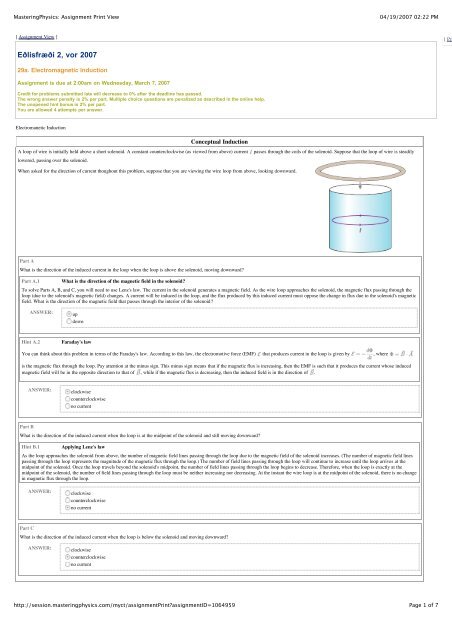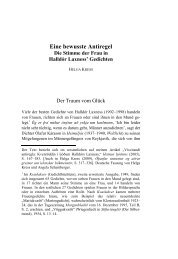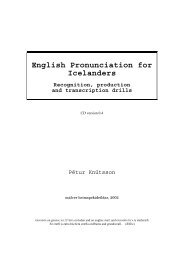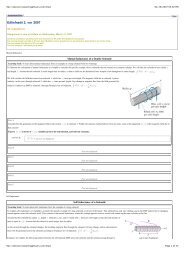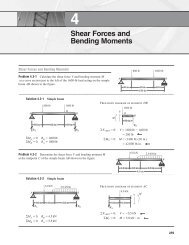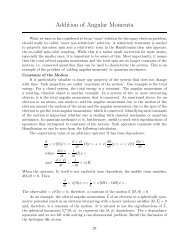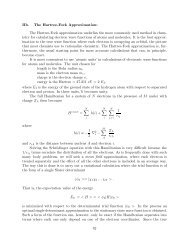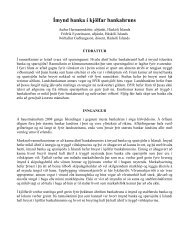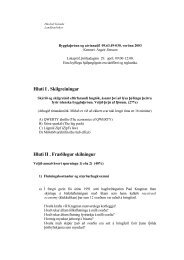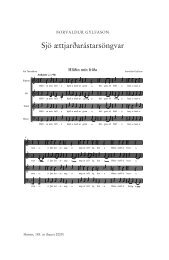MasteringPhysics: Assignment Print View
MasteringPhysics: Assignment Print View
MasteringPhysics: Assignment Print View
Create successful ePaper yourself
Turn your PDF publications into a flip-book with our unique Google optimized e-Paper software.
<strong>MasteringPhysics</strong>: <strong>Assignment</strong> <strong>Print</strong> <strong>View</strong><br />
[ <strong>Assignment</strong> <strong>View</strong> ]<br />
Eðlisfræði 2, vor 2007<br />
29a. Electromagnetic Induction<br />
<strong>Assignment</strong> is due at 2:00am on Wednesday, March 7, 2007<br />
Credit for problems submitted late will decrease to 0% after the deadline has passed.<br />
The wrong answer penalty is 2% per part. Multiple choice questions are penalized as described in the online help.<br />
The unopened hint bonus is 2% per part.<br />
You are allowed 4 attempts per answer.<br />
Electromanetic Induction<br />
Conceptual Induction<br />
http://session.masteringphysics.com/myct/assignment<strong>Print</strong>?assignmentID=1064959<br />
04/19/2007 02:22 PM<br />
A loop of wire is initially held above a short solenoid. A constant counterclockwise (as viewed from above) current passes through the coils of the solenoid. Suppose that the loop of wire is steadily<br />
lowered, passing over the solenoid.<br />
When asked for the direction of current thoughout this problem, suppose that you are viewing the wire loop from above, looking downward.<br />
Part A<br />
What is the direction of the induced current in the loop when the loop is above the solenoid, moving downward?<br />
Part A.1 What is the direction of the magnetic field in the solenoid?<br />
To solve Parts A, B, and C, you will need to use Lenz's law. The current in the solenoid generates a magnetic field. As the wire loop approaches the solenoid, the magnetic flux passing through the<br />
loop (due to the solenoid's magnetic field) changes. A current will be induced in the loop, and the flux produced by this induced current must oppose the change in flux due to the solenoid's magnetic<br />
field. What is the direction of the magnetic field that passes through the interior of the solenoid?<br />
ANSWER: up<br />
down<br />
Hint A.2 Faraday's law<br />
You can think about this problem in terms of the Faraday's law. According to this law, the electromotive force (EMF) that produces current in the loop is given by , where<br />
is the magnetic flux through the loop. Pay attention at the minus sign. This minus sign means that if the magnetic flux is increasing, then the EMF is such that it produces the current whose induced<br />
magnetic field will be in the opposite direction to that of , while if the magnetic flux is decreasing, then the induced field is in the direction of .<br />
Part B<br />
ANSWER: clockwise<br />
counterclockwise<br />
no current<br />
What is the direction of the induced current when the loop is at the midpoint of the solenoid and still moving downward?<br />
Hint B.1 Applying Lenz's law<br />
As the loop approaches the solenoid from above, the number of magnetic field lines passing through the loop due to the magnetic field of the solenoid increases. (The number of magnetic field lines<br />
passing through the loop represents the magnitude of the magnetic flux through the loop.) The number of field lines passing through the loop will continue to increase until the loop arrives at the<br />
midpoint of the solenoid. Once the loop travels beyond the solenoid's midpoint, the number of field lines passing through the loop begins to decrease. Therefore, when the loop is exactly at the<br />
midpoint of the solenoid, the number of field lines passing through the loop must be neither increasing nor decreasing. At the instant the wire loop is at the midpoint of the solenoid, there is no change<br />
in magnetic flux through the loop.<br />
Part C<br />
ANSWER: clockwise<br />
counterclockwise<br />
no current<br />
What is the direction of the induced current when the loop is below the solenoid and moving downward?<br />
ANSWER: clockwise<br />
counterclockwise<br />
no current<br />
Page 1 of 7<br />
[ Pri
<strong>MasteringPhysics</strong>: <strong>Assignment</strong> <strong>Print</strong> <strong>View</strong><br />
Faraday's Law<br />
Introduction to Faraday's Law<br />
Learning Goal: To understand the terms in Faraday's law for magnetic induction of electric fields, and contrast these fields with those produced by static charges.<br />
http://session.masteringphysics.com/myct/assignment<strong>Print</strong>?assignmentID=1064959<br />
04/19/2007 02:22 PM<br />
Faraday's law describes how electric fields and electromotive forces are generated from changing magnetic fields. It relates the line integral of the electric field around a closed loop to the change in the<br />
total magnetic field integral across a surface bounded by that loop:<br />
where is the line integral of the electric field, and the magnetic flux is given by<br />
where is the angle between the magnetic field and the local normal to the surface bounded by the closed loop.<br />
Direction: The line integral and surface integral reverse their signs if the reference direction of or is reversed. The right-hand rule<br />
applies here: If the thumb of your right hand points along , then the fingers point along . You are free to take the loop anywhere you<br />
choose, although usually it makes sense to choose it to lie along the path of the circuit you are considering.<br />
Part A<br />
Consider the direction of the electric field in the figure. Assume that the magnetic field points upward, as shown. Under what circumstances is the direction of the electric field shown in the figure<br />
correct?<br />
Hint A.1 How to approach the problem<br />
There are two approaches:<br />
One approach is to realize that the electric field would produce a current in the same direction as the field if there were a wire present. Find the magnetic field due to this (imaginary) current using the<br />
right-hand rule. The magnetic field produced by this current must oppose the change in the original magnetic field. You should be able to tell what the change is.<br />
The other approach is more mathematical. Choose a direction for and . Suppose is in the direction of the electric field shown. Then has the same direction as that of the magnetic field<br />
shown. The left-hand side of Faraday's equation is positive, and so is the magnetic flux. However, since the left-hand side is positive, the change in flux should be negative. What must have<br />
happened to the field?<br />
Part B<br />
ANSWER: always<br />
if increases with time<br />
if decreases with time<br />
depending on whether your right thumb is pointing up or down<br />
Now consider the magnetic flux through a surface bounded by the loop. Which of the following statements about this surface must be true if you want to use Faraday's law to relate the magnetic flux to<br />
the line integral of the electric field around the loop?<br />
ANSWER: The surface must be the circular disk in the middle of the loop.<br />
The surface must be perpendicular to the magnetic field at each point.<br />
The surface can be any surface whose edge is the loop.<br />
The surface can be any surface whose edge is the loop as long as no magnetic field line passes through it more than once.<br />
You are free to take any surface bounded by the loop as the surface over which to evaluate the integral. The result will always be the same, owing to the continuity of magnetic field lines (they<br />
never start or end anywhere, since there are no magnetic charges).<br />
It is important to understand the vast differences between electric fields produced by changing magnetic fields via Faraday's law and the more familiar electric fields produced by charges via Coulomb's<br />
law. Here are some short questions that illustrate these differences.<br />
Part C<br />
When can an electric field be measured at any point from the force on a stationary test charge at that point?<br />
Hint C.1 Force on a stationary charge<br />
Recall that the total force on a charge is<br />
If the charge is stationary, i.e., , then the force reduces to .<br />
ANSWER: only if the field is generated by the coulomb field of static charges<br />
only if the field is generated by a changing magnetic field<br />
.<br />
,<br />
,<br />
Page 2 of 7
<strong>MasteringPhysics</strong>: <strong>Assignment</strong> <strong>Print</strong> <strong>View</strong><br />
only if the field is generated by a changing magnetic field<br />
no matter how the field is generated<br />
In fact, this operation defines an electric field. Similarly, if the test charge is moving, it will measure magnetic fields.<br />
Part D<br />
When can an electric field that does not vary in time arise?<br />
ANSWER: only if the field is generated by a coulomb field of static charges<br />
only if the field is generated by a changing magnetic field<br />
in either of the above two cases<br />
Electric fields never vary in time; otherwise, a charge could gain energy from the field.<br />
Part E<br />
When will the integral around any closed loop of the projection of the electric field along that loop be zero?<br />
ANSWER: only if the field is generated by the coulomb field of static charges<br />
only if the field is generated by the coulomb field of static charges or a constant current<br />
only if the field is generated by a changing magnetic field<br />
however the field is generated<br />
The loop integral is always zero; otherwise, a charge moving around the loop would gain energy.<br />
http://session.masteringphysics.com/myct/assignment<strong>Print</strong>?assignmentID=1064959<br />
04/19/2007 02:22 PM<br />
The electric field generated by a static charge or a constant current always has zero loop integral. A constant current is a continuous line of evenly-spaced charges moving with constant velocity.<br />
An electric field generated by any other configuration of moving charges (moving through the loop) would have a non-zero loop integral.<br />
Here is a simple quantitative problem that uses Faraday's law.<br />
Part F<br />
A cylindrical iron rod of infinite length with cross-sectional area is oriented with its axis of symmetry coincident with the z axis of a cylindrical coordinate system as shown in the figure. It has a<br />
magnetic field inside that varies according to . Find the theta component of the electric field at distance from the z axis, where is larger than the radius of the rod.<br />
Hint F.1 Selecting the loop<br />
You want to find , but Faraday's law determines only an integral of the field. Therefore, you must pick the loop around which you will integrate in such a way that it involves only one<br />
value of and has a constant projection of along it. Such a loop is a circle with fixed (at any z, since the rod extends infinitely in the z direction).<br />
Part F.2 Find the magnetic flux<br />
Faraday's law states that . Therefore, to find the electric field you must first find the magnetic flux. What is the magnetic flux at time ?<br />
Hint F.2.a The flux integral<br />
The flux integral for a constant field is the product of the magnitude of the perpendicular magnetic field and the area over which the integral is evaluated.<br />
Express your answer in terms of the magnetic field variables and , , and .<br />
ANSWER: =<br />
Part F.3 Finding the EMF from Faraday's law<br />
From the previous part, you found that . According to Faraday's law, . Use your equation for to find the EMF predicted by Faraday's law.<br />
Express your answer in terms of , , , , and any necessary constants.<br />
ANSWER: =<br />
Hint F.4 Help from symmetry<br />
The rod extends along the entire z axis, so the electric field cannot depend on . Since the rod is cylindrically symmetric, the field cannot depend on either. Thus, the component of the electric<br />
field is a function only of .<br />
Page 3 of 7
<strong>MasteringPhysics</strong>: <strong>Assignment</strong> <strong>Print</strong> <strong>View</strong><br />
Part F.5 Find the EMF in terms of<br />
http://session.masteringphysics.com/myct/assignment<strong>Print</strong>?assignmentID=1064959<br />
04/19/2007 02:22 PM<br />
By definition, the EMF around a loop is given by . The dot product means that you need consider only the component of parallel to . Find the relationship between and .<br />
Hint F.5.a The component of the field along the loop<br />
Since the loop is a circle with constant but varying , the component of the electric field is the component along the loop.<br />
Express in terms of , quantities given in the introduction to this part, and familiar constants.<br />
ANSWER: = Answer not displayed<br />
Express your answer in terms of , , , , and any needed constants such as , , and .<br />
ANSWER: =<br />
Electric Field Due to Increasing Flux<br />
Learning Goal: To work through a straightforward application of Faraday's law to find the EMF and the electric field surrounding a region of increasing flux<br />
Faraday's law describes how electric fields and electromotive forces are generated from changing magnetic fields. This problem is a prototypical example in which an increasing magnetic flux generates<br />
a finite line integral of the electric field around a closed loop that surrounds the changing magnetic flux through a surface bounded by that loop. A cylindrical iron rod with cross-sectional area is<br />
oriented with its symmetry axis coincident with the z axis of a cylindrical coordinate system as shown. It has a uniform magnetic field inside that varies according to . In other words,<br />
the magentic field is always in the positive z direction, and it has no other components.<br />
For your convenience, we restate Faraday's law here: , where is the line integral of<br />
the electric field, and the magnetic flux is given by , where is the angle between the magnetic<br />
field and the local normal to the surface bounded by the closed loop.<br />
Direction: The line integral and surface integral reverse their signs if the reference direction of or is reversed. The right-hand rule<br />
applies here: If the thumb of your right hand is taken along , then the fingers point along . You are free to take the loop anywhere you<br />
choose, although usually it makes sense to choose it to lie along the path of the circuit you are considering.<br />
Part A<br />
Find , the electromotive force (EMF) around a loop that is at distance from the z axis, where is restricted to the region outside the iron rod as shown. Take the direction shown in the<br />
figure as positive.<br />
Hint A.1 Selecting the loop<br />
Part A.2 Find the magnetic flux<br />
Express in terms of , , , , and any needed constants such as , , and .<br />
Part B<br />
ANSWER: = Answer not displayed<br />
Hint not displayed<br />
Part not displayed<br />
Due to the cylindrical symmetry of this problem, the induced electric field can depend only on the distance from the z axis, where is restricted to the region outside the iron rod. Find this<br />
field.<br />
Part B.1 Calculate the line integral<br />
Hint B.2 The z and r components of the electric field<br />
Part not displayed<br />
Hint not displayed<br />
Express in terms of quantities given in the introduction (and constants), using the unit vectors in the cylindrical coordinate system, , , and .<br />
ANSWER: = Answer not displayed<br />
Motion-Induced EMF's<br />
Motion-Induced Electric Fields and Motional EMF<br />
Page 4 of 7
<strong>MasteringPhysics</strong>: <strong>Assignment</strong> <strong>Print</strong> <strong>View</strong><br />
Learning Goal: To understand that the motion of a conductor through a magnetic field generates a perpendicular electric field.<br />
http://session.masteringphysics.com/myct/assignment<strong>Print</strong>?assignmentID=1064959<br />
04/19/2007 02:22 PM<br />
A conducting rod of length is moved at a constant velocity through a uniform magnetic field . This field runs perpendicularly out of the page. The end of the rod at is labeled a, and the<br />
end of the rod at is labeled b.<br />
Part A<br />
As a result of the motion through the magnetic field, a charge in the rod will experience a force : the usual part of the Lorentz force for charges moving through magnetic fields. This<br />
force will push the charge in the rod, and hence this force will be an electromotive force (EMF). For now, we shall say that the force that moves the charges is due to an induced electric field ,<br />
which will enable us to calculate the EMF. The fact that there is an induced electric field at all is rather subtle, because there is no closed loop that encloses some changing flux. Therefore, a method<br />
that does not involve Faraday's law must be used to solve this motional EMF problem. In fact, this problem is a good introduction to some of the ideas behind Faraday's law. Find the y component of<br />
the induced electric field .<br />
Part A.1 Find the force on a charge due to motion in the magnetic field<br />
Part A.2 Find an equivalent electric field<br />
Express your answer in terms of the variables given in the problem introduction.<br />
Part B<br />
Part C<br />
ANSWER: = Answer not displayed<br />
Part not displayed<br />
Part not displayed<br />
Part not displayed<br />
There is a big complication in measuring the EMF generated by the moving rod: The wires that connect the meter to the rod also move through the magnetic field, and therefore, there is an<br />
electromotive force for them also. This is a general problem: A voltmeter can measure the EMF produced only in a closed loop around the circuit. In general, the EMF caused by the motion of a rod<br />
through a uniform magnetic field will be canceled by the opposite EMF induced by the motion of the rest of the circuit through this same uniform field. The only way to get a nonzero voltmeter reading<br />
is to make the field nonuniform, for example, such that the bar is moving through a region of nonzero field, but the rest of the circuit is (temporarily) moving in a region of zero field. For example,<br />
consider the arrangement shown in the figure for measuring the EMF in the moving rod using a voltmeter.<br />
In this arrangement, only for and .<br />
The hookup wires and voltmeter will have to move with the rod; they are rigid and of the dimensions and shape shown. The physical setup<br />
is that shown at the end of Part B. Which graph shown best represents the magnitude of that will be measured by the voltmeter? Take<br />
to be the moment pictured in the diagram.<br />
Hint C.1 How to approach the problem<br />
Part C.2 Describe the EMF when only the rod moves through the field<br />
Part C.3 Describe the EMF when the whole circuit is moving through the field<br />
Part D<br />
ANSWER: Answer not displayed<br />
Hint not displayed<br />
Part not displayed<br />
Part not displayed<br />
Part not displayed<br />
Page 5 of 7
<strong>MasteringPhysics</strong>: <strong>Assignment</strong> <strong>Print</strong> <strong>View</strong><br />
Rail Gun<br />
http://session.masteringphysics.com/myct/assignment<strong>Print</strong>?assignmentID=1064959<br />
04/19/2007 02:22 PM<br />
This problem explores how a current-carrying wire can be accelerated by a magnetic field. You will use the ideas of magnetic flux and the EMF due to change of flux through a loop. Note that there is<br />
an involved follow-up part that will be shown once you have found the answer to Part B.<br />
Part A<br />
A conducting rod is free to slide on two parallel rails with negligible friction. At the right end of the rails, a voltage source of strength in series with a resistor of resistance makes a closed circuit<br />
together with the rails and the rod. The rails and the rod are taken to be perfect conductors. The rails extend to infinity on the left. The arrangement is shown in the figure.<br />
There is a uniform magnetic field of magnitude , pervading all space, perpendicular to the plane of rod and rails. The rod is released from<br />
rest, and it is observed that it accelerates to the left. In what direction does the magnetic field point?<br />
Hint A.1 The force on a conducting rod due to a magnetic field<br />
There is a force on the rod because a current is flowing through it. Hence charges are moving perpendicular to the magnetic field. The rod experiences a force , which is given by .<br />
Hint A.2 The direction of the magnetic field<br />
Use the right-hand rule with the cross product: Take your right hand and point with your index finger in the direction of the rail's motion, and point your middle finger in the direction of . Your<br />
thumb will then point in the direction of the magnetic field.<br />
Part B<br />
ANSWER: into the plane of the figure<br />
out of the plane of the figure<br />
Assuming that the rails have no resistance, what is the most accurate qualitative description of the motion of the rod?<br />
Hint B.1 Lenz's law<br />
An EMF is induced in the circuit due to the change in magnetic flux through it. But will this EMF increase the current through the loop or decrease it by opposing the voltage coming from the source?<br />
Lenz's law states that induced currents will always flow in such a way that they oppose the change in flux that caused them.<br />
Hint B.2 Appyling Lenz's law to this problem<br />
Let us apply Lenz's law here. We want to find the direction of the induced current. The change in flux that induced this current is caused by the motion of the rod, which in turn is caused by the<br />
current flowing around the circuit due to the voltage source. The induced current works against that source current, and reduces it. Alternatively, one could say that the induced EMF opposes the<br />
voltage from the source.<br />
Hint B.3 The velocity of the rod<br />
The higher the velocity of the rod, the higher the induced EMF, and the lower the current flowing through the loop. But the force accelerating the rod is proportional to the current. Hence the<br />
acceleration goes down as the velocity goes up. The velocity cannot increase beyond the point at which the induced EMF is equal and opposite to .<br />
Part C<br />
ANSWER: The rod will accelerate but the magnitude of the acceleration will decrease with time; the velocity of the rod will approach but never exceed a certain terminal velocity.<br />
Under these idealized conditions the rod will experience constant acceleration and the velocity of the rod will increase indefinitely.<br />
The rod will accelerate indefinitely with acceleration proportional to its (increasing) velocity.<br />
What is the acceleration of the rod? Take to be the mass of the rod.<br />
Part C.1 Find the induced EMF<br />
To determine the current, we need the EMF induced by the change in magnetic flux through the current loop of area . Faraday's law states that . The<br />
motion of the rod will change according to . What is the EMF ?<br />
Express in terms of the velocity , the separation of the rails , and the magnetic field .<br />
ANSWER: =<br />
Part C.2 Find the current in the rod<br />
We can find the current through the rail by using Kirchhoff's rule for a closed circuit: , where is the induced EMF. What is the current ?<br />
Express your answer in terms of and other given quantities.<br />
ANSWER:<br />
Page 6 of 7
<strong>MasteringPhysics</strong>: <strong>Assignment</strong> <strong>Print</strong> <strong>View</strong><br />
ANSWER: =<br />
Part C.3 Find the acceleration of the rod<br />
http://session.masteringphysics.com/myct/assignment<strong>Print</strong>?assignmentID=1064959<br />
04/19/2007 02:22 PM<br />
To find the acceleration , we need the force on the rod. We have already determined its direction. The magnitude of this force is given in Part A.i. Write down an expression for , using<br />
Newton's second law.<br />
Expres your answer in terms of mass , current , , and .<br />
ANSWER: =<br />
Express your answer as a function of , , the velocity of the rod , , , and the mass of the rod .<br />
ANSWER: =<br />
Making the substitution , you obtain the dfferential equation<br />
which you can solve to find the velocity of the rod as a function of time:<br />
To achieve a high acceleration, which is necessary for a useful gun, a magnetic field of large magnitude and a high voltage are advantageous.<br />
Part D<br />
What is the terminal velocity reached by the rod?<br />
Part D.1 Find an expression for the terminal velocity<br />
ANSWER: =<br />
Part not displayed<br />
A larger magnetic field increases the acceleration of the rod, but lowers the terminal velocity: a trade-off for rail gun engineers!<br />
Summary 3 of 5 problems complete (44.22% avg. score)<br />
9.55 of 12 points<br />
.<br />
,<br />
Page 7 of 7


